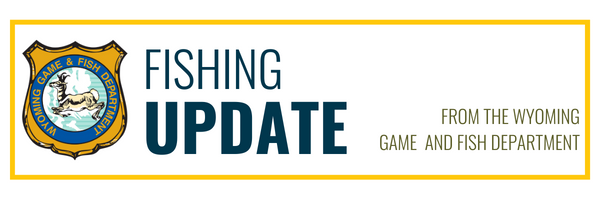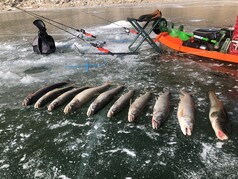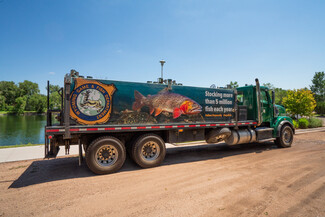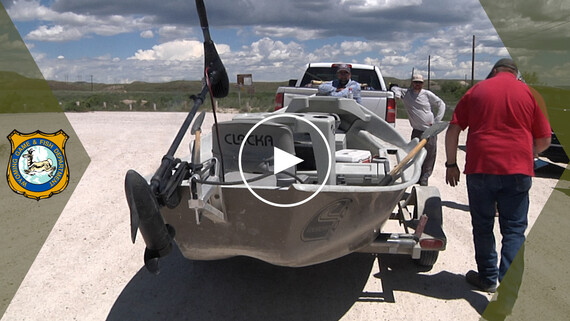|

 New Zealand mudsnails are not new to Wyoming ? in fact they were introduced more than two decades ago. Once introduced, eradicating them from a water source is extremely difficult, if not impossible. Populations continue to pop up across the state, most often in areas with high use, like Gray Reef, Wedding of the Waters, and?Flaming Gorge.?
As you move around between fishing sites, be aware that you could have unseen hitchhikers on your waders or other fishing equipment.?Anglers should always follow the Clean, Drain, Dry?process each time they hit the water ? this is the best way to ensure that you don't spread invasive species. New Zealand mudsnails can cause major issues wherever they are introduced.
|
|
Join us for our first ever overnight fishing camp at Whiskey Mountain Conservation Camp!
|
|
Ice-off coming soon at Flaming Gorge Reservoir
 Following an excellent winter for ice fishing at Flaming Gorge Reservoir, forecasted temperatures indicate that ice-off is coming soon. ?Anglers need to be cautious of quickly changing ice conditions as the weather warms up, causing ice to deteriorate quickly.? Days are getting longer and the shoreline ice will be the first to go.? said John Walrath, Green River Fisheries Biologist. The spring thaw brings with it opportunities for great shore fishing.?
|
|
How does Game and Fish transport fish for stocking in Wyoming?

The Wyoming Game and Fish Department stocks over 300 Wyoming waters annually from our 10 hatcheries with specialized pickups and trucks. We have eleven 300 gallon, four 650 gallon and three 2,400 gallon fish distribution tank vehicles. Each tank is equipped with life support systems to keep fish alive. These include, air scoops and aerators to help remove carbon dioxide, micro-bubble oxygen diffusers to keep oxygen in the water for fish, and adequate insulation to help keep the water temperature cool. We also have a routine to make sure they stay healthy during their move.
LOADING
- Prior to being loaded for transport, hatchery crew will stop feeding fish for 2-3 days so their digestive tracts have time to purge and reduce the build-up of ammonia during transport.
- Next, fish culturists determine how many fish are in one pound. That varies based on the fish size and species we plan to stock. For small loads of fish (300-800 lbs), hatchery crews will typically use a net, bucket and platform scale to manually weigh and load the fish. For larger loads of fish (900-4000 lbs), we use truck scales and fish pumps.
- During the loading, salt and no-foam are added to the water tank. No-foam is a silicone-based product that breaks up the foam layer that builds up on the water surface, which prevents gases like carbon dioxide from escaping. Salt helps fish balance electrolytes, therefore reducing stress.
TRANSPORTING
- As soon as the fish are all loaded onto the truck, the driver ensures all life support systems are functioning before hitting the road and will check on the fish at regular intervals throughout the trip.
- The driver also has information systems to actively monitor oxygen concentrations in the tanks while driving down the road.
STOCKING
- Upon arrival at the stocking location, and prior to releasing them into a pond, lake or river, we take pH and water temperature readings to make sure the water chemistry is suitable for stocking. In the summer surface water temperatures and pH values can shift to warmer and more basic. The optimal pH range for trout would fall in the 6.5-9.0 range and water temperatures should be 40-65 degrees Fahrenheit.
- For stocking, a hose is attached to the tank and the fish are released into a deep pool area so fish aren?t damaged on their way out of the truck.
- Fish are monitored for about ten minutes to make sure they all swim away strong and healthy.
The Wyoming Game and Fish starts stocking fish in late March and usually finishes up in late November every year. Check out these past stocking reports on the Game and Fish website.
|
|
|
|
Spring and summer feels frustratingly close, but boating season has already?sort of?started in the state. Watercraft inspections have resumed around the state, meaning any watercraft transported into Wyoming until Nov. 30th must undergo a mandatory inspection for aquatic invasive species. Inspections must be done by a certified AIS inspector prior to launching on any Wyoming waters.

|
|
 Sportsperson Hotline: ?(307) 777-4600?| Open?8 a.m.- 5 p.m. MT Monday-Friday
The Wyoming Game and Fish Department manages and conserves more than 800 species of fish and wildlife across Wyoming. ?For nearly 120 years, we?ve carried out our mission to conserve wildlife and serve people. Through these efforts, the Wyoming Game and Fish Department ensures the public continues to enjoy Wyoming?s vast fish and wildlife resource ?through ?hunting, fishing, trapping, wildlife watching and other forms of outdoor recreation. Hunters, anglers and wildlife watchers contribute over a billion dollars to Wyoming?s economy each year.
|
|
|
|
